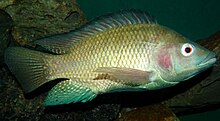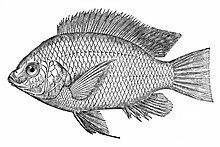Nile tilapia
| Nile tilapia | |
|---|---|

| |

| |
aquacultured type (likely of hybrid origin) below
| |
| Scientific classification | |
| Domain: | Eukaryota |
| Kingdom: | Animalia |
| Phylum: | Chordata |
| Class: | Actinopterygii |
| Order: | Cichliformes |
| Family: | Cichlidae |
| Genus: | Oreochromis |
| Species: | O. niloticus
|
| Binomial name | |
| Oreochromis niloticus | |
| Synonyms | |
| |
The Nile tilapia (Oreochromis niloticus) is a species of tilapia, a cichlid fish native to parts of Africa and the Levant, particularly Israel and Lebanon.[2] Numerous introduced populations exist outside its natural range.[1][3] It is also commercially known as mango fish (not to be confused with mango tilapia, or Sarotherodon galilaeus), nilotica, or boulti.[4]
Description
The Nile tilapia reaches up to 60 cm (24 in) in length,[2] and can exceed 5 kg (11 lb).[5] As typical of tilapia, males reach a larger size and grow faster than females.[5]
Nile tilapia can live for more than 10 years.[5]
Range and habitat
The Nile tilapia is native to larger parts of
The Nile tilapia can be found in most types of
Subspecies

Although
- O. n. niloticus (Linnaeus, 1758) – most of species' range
- O. n. baringoensis Trewavas, 1983 – Lake Baringo in Kenya
- O. n. cancellatus (Nichols, 1923) – Awash basin in Ethiopia
- O. n. eduardianus (Boulenger, 1912) – Albertine Rift Valley lakes
- O. n. filoa Trewavas, 1983 – hot springs in Awash basin in Ethiopia
- O. n. sugutae Trewavas, 1983 – Karpeddo soda springs at Suguta River in Kenya
- O. n. tana Seyoum & Kornfield, 1992 – Lake Tana in Ethiopia
- O. n. vulcani Trewavas, 1933 – Lake Turkana in Ethiopia and Kenya
While the species is overall very widespread and common, the
A population found in Lake Bogoria appears to be an undescribed subspecies.[8]
The forms referred to as Oreochromis (or Tilapia) nyabikere and kabagole seem to belong to this species, too. An undescribed population found at, for example, Wami River, Lake Manyara, and Tingaylanda seems to be a close relative.[11]
Behavior
Feeding
The Nile tilapia is mostly a
The Nile tilapia typically feeds during daytime, which suggests that, similar to trout and salmon, it exhibits a behavioral response to light as a main factor contributing to feeding activity. Due to its fast reproductive rate, however, overpopulation often results within groups of Nile tilapia. To obtain the necessary nutrients, night feeding may also occur due to competition for food during daylight. A recent study found evidence that, contrary to popular belief, size dimorphism between the sexes results from differential food conversion efficiency rather than different amounts of food consumed. Hence, although males and females eat equal amounts of food, males tend to grow larger due to a higher efficiency of converting food to body weight.[13]
Social organization
Groups of Nile tilapia establish social
Like other tilapias, such as
Reproduction
Typical of most fish, Nile tilapia reproduce through mass
Female Nile tilapia, in the presence of other females either visually or chemically, exhibit shortened interspawning intervals. Although
Parental care
Species belonging to the genus
Since female Nile tilapia exhibiting parental care show extended interspawning periods, one of the benefits is slowing down vitellogenesis (yolk deposition) to increase the survival rate of one's own young. The size of spawned eggs correlates directly with advantages concerning hatching time, growth, survival, and onset of feeding, since increased egg size means increased nutrients for the developing young. Thus, one of the reasons behind a delayed interspawning period by female Nile tilapia may be for the benefit of offspring survival.[18][21]
Aquaculture

Tilapia, likely the Nile tilapia, was well known as food fish in
As food

The red-hybrid Nile tilapia is known in the Thai language as pla thapthim (Thai: ปลาทับทิม), meaning "pomegranate fish" or "ruby fish".[24] This type of tilapia is very popular in Thai cuisine, where it is prepared in a variety of ways.[25]
The black-and-white-striped tilapia pla nin (Thai: ปลานิล), has darker flesh and is commonly either salted and grilled or deep-fried, and it can also be steamed with lime (pla nin nueng manao).[26]
Nile tilapia, called بلطي bulṭī in
In Israel, Nile tilapia is commonly fried, grilled or baked with vegetables herbs and spices and eaten with rice or bulgur pilafs. It is also baked in the oven with tahini sauce drizzled over it with potatoes, onions, asparagus, sweet peppers or tomatoes and flavored with sumac and dried mint.[citation needed]
Tilapia, often farmed, is a popular and common supermarket fish in the United States.[citation needed]
In India, Nile tilapia is the most dominant fish in some of the South Indian reservoirs and available throughout the year. O. niloticus grows faster and reaches bigger sizes in a given time. The littoral areas of Kelavarappalli Reservoir are full of nests of Nile tilapia and they breed during south-west monsoon (July–September). The fish mainly feed on detritus. Zooplankton, phytoplankton, and macrophytes also were recorded occasionally from the gut of Nile tilapia. The demand is heavy, especially from local poor people, as this fish is affordable to the lowest income group in this area.[27]
See also
- Nile perch — a similar-named but different fish that grows much larger and is highly predatory
- Fishing in Israel
References
- ^ . Retrieved 19 November 2021.
- ^ a b c d e f g h i j k Froese, Rainer; Pauly, Daniel (eds.) (2015). "Oreochromis niloticus" in FishBase. November 2015 version.
- .
- S2CID 31199737.
- ^ a b c d e f Nico, L.G.; P.J. Schofield; M.E. Neilson (2019). "Oreochromis niloticus (Linnaeus, 1758)". Food and Agriculture Organization, United Nations. Retrieved 5 November 2019.
- ^ a b c d Nico, L.G.; P.J. Schofield; M.E. Neilson (2019). "Oreochromis niloticus (Linnaeus, 1758)". U.S. Geological Survey, Nonindigenous Aquatic Species Database. Retrieved 5 November 2019.
- ^ .
- ^ S2CID 109938635.
- ISSN 0971-751X. Retrieved 2023-08-21.
- ^ Trewavas, E. (1983). Tilapiine Fishes of the genera Sarotherodon, Oreochromis and Danakilia. Natural History Museum, London.
- PMID 11527464.
- ^ "Nile tilapia can fight malaria mosquitoes", BBC News, 8 August 2007.
- ^ S2CID 25867399.
- ^ PMID 19330265.
- .
- .
- ^ PMID 17354460.
- ^ .
- PMID 22031714.
- ^ "Oreochromis niloticus (Nile tilapia)" (PDF). UWI.
- ^ Rana, Kausik J. (1986). "Parental influences on egg quality, fry production and fry performance in Oreochromis niloticus (Linnaeus) and O. mossambicus (Peters)". University of Stirling.
- S2CID 16767145.
- ^ a b "Tilapia". Archived from the original on 2012-10-16. Retrieved 2007-07-12.
- ^ https://web.archive.org/web/20170623071944/http://www.fishtech.mju.ac.th/FishNew1/OSS/files/ByBUzsfTue53948.pdf Management Guidelines of Red Tilapia Culture in Cages, Trang Province (in Thai)
- ^ "Recipes for Thaptim Fish". Archived from the original on 2009-09-10. Retrieved 2013-10-05.
- ^ Fish breeding in Thailand
- .
External links
- View the oreNil2 genome assembly in the UCSC Genome Browser.
Further reading
- "Oreochromis niloticus". Integrated Taxonomic Information System. Retrieved 11 March 2006.
- Bardach, J.E.; Ryther, J.H. & McLarney, W.O. (1972): Aquaculture. the Farming and Husbandry of Freshwater and Marine Organisms. John Wiley & Sons.

